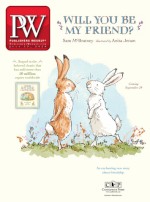Dublin artist Kristensen’s debut graphic novel, What We Don’t Talk About (Avery Hill, Sept.), focuses on an uncomfortable weekend trip taken by Farai and Adam, a young interracial couple.
What was the seed of an idea that got you started?
It’s quite personal; I grew up in an interracial family. My mom is Zimbabwe-born and my dad’s Danish. I grew up seeing ugly stuff happening, particularly on my dad’s side of the family, who weren’t really accepting of my mom. It’s weird growing up with different identities, but also feeling like you’re not completely accepted by your white family. I always wanted to write about a strong character like Farai, someone who really knows her worth.
How did you want this book to be different than other stories about interracial couples?
So many films will end like “love overcomes anything,” but they don’t talk about the complexity of being with someone who’s different than you and had a different experience of the world. I wanted Adam to be a complicated character that you didn’t necessarily hate, but he was in conflict with himself because he couldn’t really accept that he was with a Black person. I wanted to show that you could love someone, but you could still hurt them. Even though this story obviously touches on racism, I think a lot of people can relate to it in terms of lack of communication in a relationship.
During the weekend, Adam’s mom makes racist microaggressions—small comments about African cultures and Farai’s outfits—are they drawn from real life?
They were drawn from things I witnessed as a child, but I also reached out on Twitter. Black people told me about all these different experiences. But my inspiration was my parents. My mom was in a difficult position, coming to Denmark at the age of 19, when there weren’t many Black people around. She always wants to please people, and she’s taken a lot of stuff, I can see it’s really worn her down. There was a part of me that wanted to create a heroine who responded differently.
There’s a scene where Farai is getting dressed up to join Adam’s family and deciding whether to put on her bright, African-patterned head wrap. What did that mean to you?
I started wearing a head wrap about two years ago. I remember the first time putting it on and going into public and thinking, “Wow, people are really gonna look.” Because it’s not something you see in Dublin. It’s a way for me to connect with my African roots. I wanted Farai to share that kind of connection, in moments where she’s questioning, “Should I hide myself?” and she realizes, “No, actually, I should be proud.”



 Volume 267
Issue 28
07/13/2020
Volume 267
Issue 28
07/13/2020





